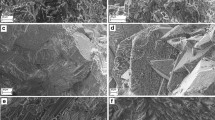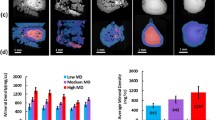Abstract
Crystal adherence to the renal epithelium is widely regarded as a probable mechanism of stone formation. Intracrystalline proteins may provide access to the core of urinary crystals and thereby facilitate the dismantling of these crystals after their attachment to and phagocytosis by renal epithelial cells. The present study investigated the role of proteolysis and limited dissolution of urinary calcium oxalate (CaOx) crystals in South Africa’s white and black populations with a view to understanding the remarkably low stone incidence in the black population compared with the whites. CaOx crystals were precipitated from filtered urine or ultrafiltered urine dosed with an intracrystalline protein, urinary prothrombin fragment 1 (UPTF1), isolated from white and black subjects. The crystals were fractured and subjected to proteolysis and/or limited dissolution before examination using field emission scanning electron microscopy (FESEM). FESEM data showed that CaOx crystals from white and black subjects were eroded by treatment with proteases. Cathepsin D caused the most significant crystal erosion, and more noticeable degradation of CaOx monohydrate (COM) crystals compared to CaOx dihydrate (COD). Limited dissolution studies showed the unique ultrastructures and fragmentation processes of COM and COD crystals. COM crystals appeared to be more susceptible to degradation and dissolution than CODs. Since COMs are predominant in blacks, compared with COD crystals from whites, it is speculated that the lower stone rate amongst South African blacks might be attributed partly to their more efficient destruction of retained COM crystals.









Similar content being viewed by others
References
Lieske JC, Toback FG (1996) Interaction of urinary crystals with renal epithelial cells in the pathogenesis of nephrolithiasis. Semin Nephrol 6: 458
Lieske JC, Deganello S, Toback FG (1999) Cell-crystal interactions and kidney stone formation. Nephron 81: 8
De Water R, Noordermeer C, Van der Kwast TH, Nizze H, Boevé ER, Kok DJ, Schröder FH (1999) Calcium oxalate nephrolithiasis: Effects of renal crystal deposition on the cellular composition of the renal interstitium. Am J Kidney Dis 33: 761
De Water R, Leenan PJM, Noordermeer C, Nigg AL, Houtsmuller AB, Kok DJ, Schröder FH (2001) Cytokine production induced by binding and processing of calcium oxalate crystals in cultured macrophages. Am J Kidney Dis 38: 331
Lieske JC, Leonard R, Toback FG (1995) Adhesion of calcium oxalate monohydrate crystals to renal epithelial cells is inhibited by specific anions. Am J Physiol 268: F604
Yamate T, Kohri K, Umekawa T (1996) The effect of osteopontin on the adhesion of calcium oxalate crystals to Madin-Darby canine kidney cells. Eur Urol 30: 388
Yamate T, Kohri K, Konya E, Ishikawa Y, Iguchi M, Kurita T (1999) Interaction between osteopontin on Madin Darby canine kidney cell membrane and calcium oxalate crystal. Urol Int 62: 81
Ebisuno S, Umehara M, Kohjimoto Y, Ohkawa T (1999) The effects of human urine on the adhesion of calcium oxalate crystals to Madin-Darby canine kidney cells. Br J Urol Int 84: 118
Romijn JC, Schepers SJM, Duim RAJ, Schröder FH, Verkoelen CF (2001) Urinary crystallization inhibitors do not prevent crystal binding. In: DJ Kok, HC Romijn, PCMS Verhagen, CF Verkoelen (eds) Eurolithiasis, 9th European Symposium on Urolithiasis. Shaker, Maastricht, p 182
Ryall RL, Fleming DE, Grover PK, Chauvet M, Dean CJ, Marshall VR (2000) The hole truth: intracrystalline proteins and calcium oxalate kidney stones. Mol Urol 4: 391
Ryall RL, Fleming DE, Doyle IR, Evans NA, Dean CJ, Marshall VR (2001) Intracrystalline proteins and the hidden ultrastructure of calcium oxalate urinary crystals: implications for kidney stone formation. J Struct Biol 134: 5
Fleming DE, Van Riessen A, Chauvet MC, Grover PK, Hunter B, van Bronswijk W, Ryall RL (2003) Intracrystalline proteins and urolithiasis: a synchrotron X-ray diffraction study of calcium oxalate monohydrate. J Bone Miner Res 18: 1282
Fleming DE, Doyle IR, Evans N, Marshall VR, Parkinson GM, Ryall RL (1999) Proteins associated with calcium oxalate crystals formed in human urine are intracrystalline. In: Borghi L, Meschi T, Briganti A, Schanchi T, Novarini A (eds) Proceedings of the 8th European Symposium on Urolithiasis. Editoriale Bios, Cosenza, p 359
Ryall RL, Chauvet MC, Grover PK (2001) 2001: a space oddity. In: Kok DJ, Romijn HC, Verhagen PCMS, Verkoelen CF (eds) Eurolithiasis: 9th European Symposium on Urolithiasis. Shaker, Maastricht, p 273
Webber D, Rodgers AL, Sturrock ED (2003) Selective inclusion of proteins into urinary calcium oxalate crystals: comparison between stone-prone and stone-free population groups. J Crys Growth 259: 179
Ryall RL, Grover PK, Stapleton AMF, Barrell DK, Tang Y, Moritz RL, Simpson RJ (1995) The urinary F1 activation peptide of human prothrombin is a potent inhibitor of calcium oxalate crystallization in undiluted human urine in vitro. Clin Sci 89: 533
Webber D, Rodgers AL, Sturrock ED (2002) Synergism between urinary prothrombin fragment 1 and urine: a comparison of inhibitory activities in stone-prone and stone-free population groups. Clin Chem Lab Med 40: 930
Fleming DE, Grover PK, Chauvet MC, Marshall VR, Ryall RL (2000) An unexpected role of urinary proteins in the prevention of calcium oxalate urolithiasis. In: Rodgers AL, Hibbert BE, Hess B, Khan SR, Preminger GM (eds) Urolithiasis 2000. University of Cape Town, Cape Town, p 169
Modlin M (1967) The aetiology of renal stone: a new concept arising from studies on a stone-free population. Ann R Coll Surg Eng 40: 155
Whalley NA, Moraes MFBG, Shar TG, Pretorius SS, Meyers AM (1998) Lithogenic risk factors in the urine of black and white subjects. Br J Urol 82: 785
Jappie D, Rodgers AL (2000) Determination of the optimum number of subjects required for pooling of urines: statistical approach. In: Rodgers AL, Hibbert BE, Hess B, Khan SR, Preminger GM (eds) Urolithiasis 2000. University of Cape Town, Cape Town, p 92
Ryall RL, Hibberd CM, Marshall VR (1985) A method for studying inhibitory activity in whole urine. Urol Res 13: 285
Doyle IR, Marshall VR, Dawson CJ, Ryall RL (1995) Calcium oxalate crystal matrix extract: the most potent macromolecular inhibitor of crystal growth and aggregation yet tested in undiluted human urine in vitro. Urol Res 23: 53
Stapleton AMF, Dawson CJ, Grover PK, Hohmann A, Comacchio R, Boswara V, Tang Y, Ryall RL (1996) Further evidence linking urolithiasis and blood coagulation: urinary prothrombin fragment 1 is present in stone matrix. Kidney Int 49: 880
Denhardt DT, Guo X (1993) Osteopontin: a protein with diverse functions. FASEB J 7: 1475
Hoyer JR, Pietrzyk RA, Liu H, Whitson PA (1999) Effects of microgravity on urinary osteopontin. J Am Soc Nephrol 10: S389
Addadi L, Aizenberg J, Beniash E, Weiner S (1999). On the concept of a single crystal in biomineralization. In: Braga D, Grepioni F, Orpen AG (eds) Crystal engineering: from molecules and crystals to materials. Kluwer, Netherlands, p 1
Bautista DS, Denstedt J, Chambers AF, Harris AF (1996) Low molecular weight variants of osteopontin generated by serine proteases in urine of patients with kidney stones. J Cell Biochem 61: 402
Hartz PA, Wilson PD (1997) Functional defects in lysosomal enzymes in autosomal dominant polycystic kidney disease: abnormalities in synthesis, molecular processing, polarity and secretion. Biochem Mol Med 60: 8
Lepage L, Tawashi R (1982) Growth and characterization of calcium oxalate dihydrate crystals (weddelite). J Pharm Sci 71: 1059
Tomažič BB, Nancollas GH (1980) The kinetics of dissolution of calcium oxalate hydrates II. The dihydrate. Invest Urol 18: 97
Riese RJ, Riese JW, Kleinman JG, Wiessner JH, Mandel GS, Mandel NS (1988) Specificity in calcium oxalate adherence to papillary epithelial cells in culture. Am J Physiol 255: F1025
Verkoelen CF, Romijn JC, De Bruijn WC, Boeve ER, Cao L, Schroder FH (1995) Association of calcium oxalate monohydrate crystals with MDCK cells. Kidney Int 48: 129
Wesson JA, Worcester EM, Weissner JH, Mandel NS, Kleinman JG (1998) Control of calcium oxalate crystal structure and cell adherence by urinary macromolecules. Kidney Int 33: 952
Lieske JC, Norris R, Swift H, Toback FG (1997) Adhesion, internalisation and metabolism of calcium oxalate monohydrate crystals by renal epithelial cells. Calcif Tissue Int 58: 195
Huang H-S, Chen J, Chen C-F (2000) Circulating adhesion molecules and neutral endopeptidase enzymuria in patients with urolithiasis and hydronephrosis. Urology 55: 961
Baggio B, Gambaro G, Ossi E, Favaro S, Borsatti A (1983) Increased urinary excretion of renal enzymes in idiopathic calcium oxalate nephrolithiasis. J Urol 129: 1161
Hackett RL, Shevock PN, Khan SR (1994) Madin-Darby canine kidney cells are injured by exposure to oxalate and to calcium oxalate crystals. Urol Res 22: 197
Wesson JA, Worcester E (1996) Formation of hydrated calcium oxalates in the presence of poly-L-aspartic acid. Scanning Microsc 10: 415
Author information
Authors and Affiliations
Corresponding author
Rights and permissions
About this article
Cite this article
Webber, D., Chauvet, M.C. & Ryall, R.L. Proteolysis and partial dissolution of calcium oxalate: a comparative, morphological study of urinary crystals from black and white subjects. Urol Res 33, 273–284 (2005). https://doi.org/10.1007/s00240-005-0471-9
Received:
Accepted:
Published:
Issue Date:
DOI: https://doi.org/10.1007/s00240-005-0471-9




